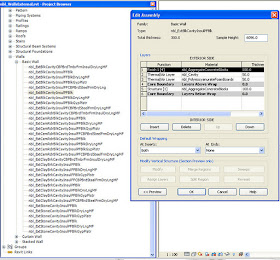.
The NBS have released a preview of the first set of content for the National BIM Library which can be downloaded using THIS HYPERLINK see also Draft content now available for comment for the Linked-In site where you can leave your comments for the NBS.
This content contains a sub-set of door, wall and partition objects in IFC and Autodesk Revit 2012 format. There is a note stating that “We’ve also had comments already mainly about naming convention, so what is presented here will probably not be the final naming convention that is released. We’d also really appreciate comments on the depth of content within the objects and the functionality of geometric parameters.”
The NBS have released a preview of the first set of content for the National BIM Library which can be downloaded using THIS HYPERLINK see also Draft content now available for comment for the Linked-In site where you can leave your comments for the NBS.
This content contains a sub-set of door, wall and partition objects in IFC and Autodesk Revit 2012 format. There is a note stating that “We’ve also had comments already mainly about naming convention, so what is presented here will probably not be the final naming convention that is released. We’d also really appreciate comments on the depth of content within the objects and the functionality of geometric parameters.”
So the question is why release this for comment when the fundamental issue of a naming convention has not been addressed?
Here is one wall system family
nbl_ExtBlkCavityCBPBrdTmbrFrmInsulDryLngMF
These Basic Wall descriptions in Camel Text format are extremely difficult to read and need underscores, spaces or minus signs between to make them easier to understand. Camel text is fine for programmers using variables when writing programs, but is totally inappropriate for use as a description of a Revit system family.
Take a look below and see which ones are easiest to read
nbl_ExtBlkCavityCBPBrdTmbrFrmInsulDryLngMF
nbl_Ext Blk Cavity CBP Brd Tmbr Frm Insu Dry Lng MF
nbl_Ext_Blk_Cavity_CBP_Brd_Tmbr_Frm_Insu_Dry_Lng_MF
nbl_Ext-Blk-Cavity-CBP-Brd-Tmbr-Frm-Insu-Dry-Lng-MF
Let’s see if we can decipher the meaning of the descriptions and how intuative or not the naming is?
Ext = External
Blk = Block
Cavity = Cavity
Insul = Insulation
FF = I have not got a clue?
CBPBrd = Ummmmm something Board
TmbrFrm = Timber Frame
DryLng = Dry Lining
MF = Umm what can be on the inside face called MF
The order appears to be from outside face to inside face so why is MF behind the DryLng?
Looking at one of the example files it appears that MF = Metal Frame ….. So what about Dabs?
.
.
Looking at nbl_ExtBlkCavityInsulFFBlk
Looking at the Edit Assembly dialogue I can’t see what FF is supposed to signify in the description?
The Material for the Thermal/Air Layer is nbl-RockWallBatts now that’s a trade name should it not be Mineral Wool?
The materials follow the same camel text format which would also benefit from the inclusions of spaces, hyphen, or underscores to make them more legible.
Aggregate Concrete Blocks as opposed to what?
We are once again on how to differentiate between Aircrete, lightweight, medium and dense concrete blocks see my blog post about Revit System Wall Families for the UK and their various properties and materials.
.
.
Looking at nbl_ExtBlkCavityInsulPFBBlk
By inspection of the Materials one can see that PFB = Polyisocyanurate Foam Board
nbl_ExtBlkCavityInsulFFBlk
So looking at the Edit Assembly dialogue the Insulation is nbl_RockWallBatts
Now isn’t Rock Wool a trade name for mineral wool? and how does this equate to the FF in the description?
This is going to take a little time to unravel because it’s poorly put together and not correctly documented. What would have been excellent would have been a guide to the naming convention being used, even if it's going to be changed.
Ralph Pullinger and I were in the process of building a catalogue of all the different UK
Within the examples released there are many wall types that are not popular and basic traditional wall types that are missing.
The spreadsheet that I created scoped out all the various materials and forms of construction that have been used since the Victorian era. Once you have completed that task and have all that information then you can establish just what terms you actually need to build an adequate naming convention and a System Wall Family.
I provided our research to the NBS so why has this not been taken into account before the release of this content for review?
.
.



Alan
ReplyDeleteFF is Full Fill
PP is Partial Fill
Wow good luck trying to sort through those type names in the properties panel. Its going to be a nightmare trying to pick the right wall to use when you only see the first few letters of the type name.
ReplyDeleteThe point of using abstracted type names is so in need, as evident in the lack of communication/usefulness the naming convention exhibits. Type Names have to be shorter than these!
ReplyDeleteNames are supposed to communicate yet these go way overboard, into Confusication.
Try explaining these to end users who haven't memorized every possible abbreviation and tell us how that goes.